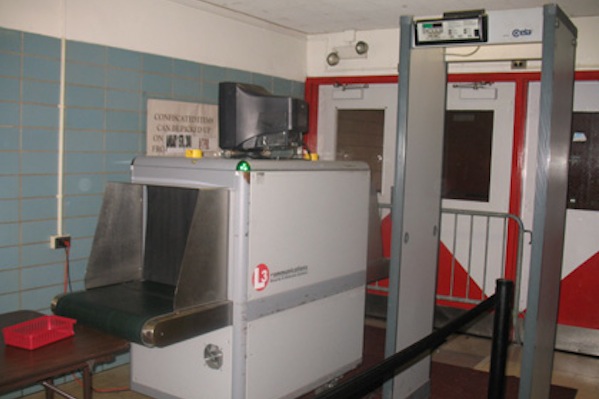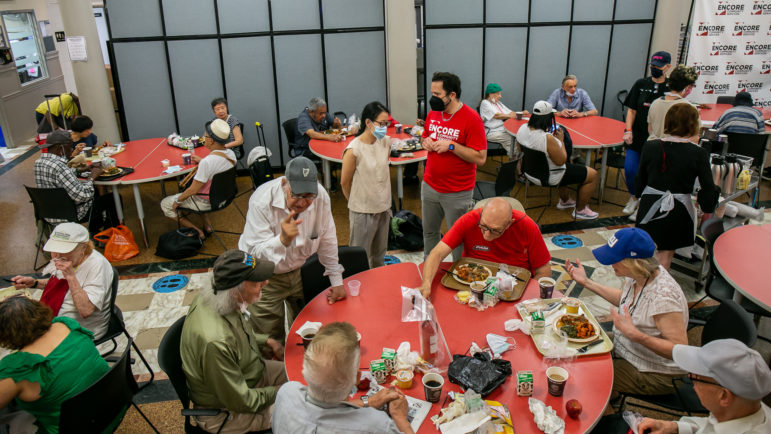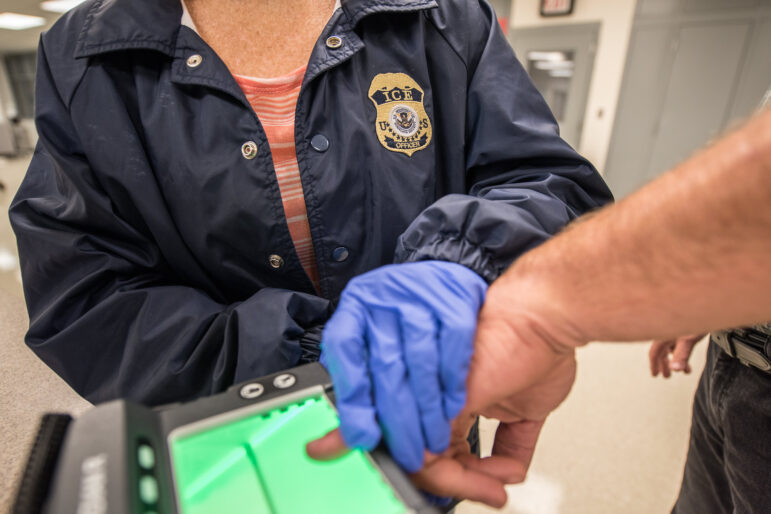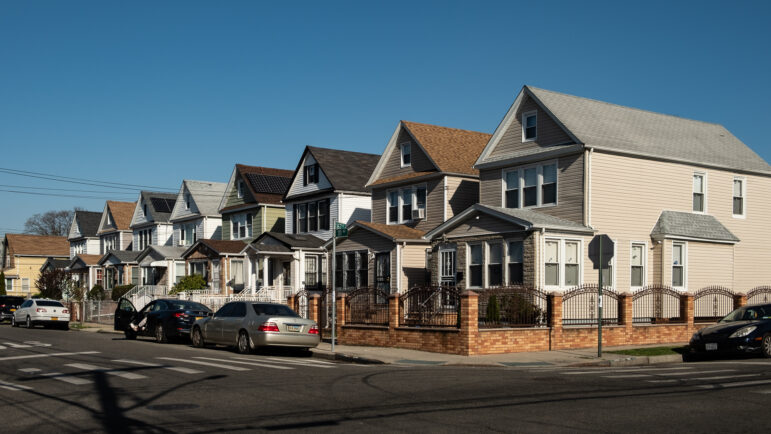
Photo by: Eileen Markey
A metal detector at John F. Kennedy High School in the Bronx.
The City Council voted Monday to approve the Student Safety Act, which mandates detailed reporting of suspensions, arrests and other school-discipline matters.
First introduced in 2008, and re-visited by the Council in 2009, the current version of the bill was introduced in September 2010, with the support of Speaker Christine Quinn and the leadership of the three sponsoring committees, for Education, Public Safety and Juvenile Justice.
Among other goals, the Act aims to clarify what’s long been a murky reporting relationship between NYPD and DOE, as safety officers are officially hired by NYPD but theoretically under DOE supervision by school principals. Too often, advocates say, disciplinary matters best handled by school officials instead become matters for school safety officers, escalating conflicts and, by responding in extremis, criminalizing behavior that may not, in fact, be breaking the law.
The more detailed reporting outlined in the Student Safety Act will permit knowledge of patterns of discipline, arrest, and detention in the city’s schoolspatterns that, advocates charge, too often reflect racial bias, as schools with permanent metal detectors, more significant police presence and greater numbers of reported incidents tend to serve communities that are largely black, Hispanic and poor. Students who require special-education services and those who are not yet fluent in English also experience a greater portion of disciplinary actions.
The Act additionally mandates reporting on school suspensions and expulsions, tracking school-level practices and breaking down data by age, grade level, race, gender and education status (special education or English language learner) to help draw a more nuanced portrait of disciplinary actions in the schools.
“This is a victory for all New York City students,” declared Nazifa Mahbub, a 17-year-old senior at Long Island City High School and a youth-organizer with Desis Rising Up and Moving (DRUM), at a City Hall rally on Thursday. “Young people have been pushed out instead of getting support for our futures. We will finally find out what is happening in our schools.”
Police in the Schools Since ‘98
A 1998 Memorandum of Understanding (MOU) between then-Mayor Giuliani and the Board of Education first permitted police officers and NYPD safety agents to provide law enforcement in the city’s schools, on the understanding that the City would not raise the number of safety officers from 1998 levels. The MOU was renewed in 2003 by Mayor Bloomberg and Chancellor Klein, despite later denials in testimony by Deputy Chancellor Kathleen Grimm and other senior NYPD and DOE officials.
Today, there are nearly 5,200 safety officers in the city’s schools, and 200 armed police officers, representing a 64 percent increase over 1998 staffing levels. By contrast, there are approximately 3,000 guidance counselors in the schools, as cuts to guidance are a frequent response to persistent budget cuts.
While most school safety officers perform their jobs with integrity, Speaker Quinn noted at Thursday’s rally, actions by some “bad apples” on the force mean that students, who are most often minors, can be subjected to tactics meant for adult suspects. New York Civil Liberties Union head Donna Lieberman said that both students and, occasionally, school leaders, have been handcuffed and detained in situations that haven’t warranted such extreme behavior.
Reporting Incidents via 311
The Safety Act originally proposed reporting of incidents through the Civilian Complaint Review Board, which hears NYPD complaints. A 2009 revision changed the reporting mechanism, instead mandating that parents and other concerned individuals report incidents via the city’s information line, 311, which would equip its operators to receive detailed incident reports. In the law that was approved today, reports made via 311 would be directed to the Police Department’s Internal Affairs Bureau, which will oversee investigations.
The new law requires that the Department of Education report annually on disciplinary practices and police action in the schools. It also mandates twice-yearly reports on suspensions, with monthly accounting of students who have been suspended or expelled, in order to look at patterns of suspension and discipline over time.
A final reporting mechanism requires the NYPD to provide the City Council with quarterly accounts of NYPD personnel activity in the schools, including which criminal and non-criminal behaviors (cutting school, lateness, disobedience, inappropriate language, etc.)
The Act’s requirement that the NYPD report quarterly on its safety officers’ actions is the first school safety police-reporting law in the U.S. that is designed specifically to document police activity in schools, and may become a template for national school safety reforms, advocates say.
Supporters of the School Safety Act include the New York City Department of Education and the New York Police Department, as well as a wide swath of youth and adult advocates, including the Urban Youth Collaborative, DRUM, Sistas and Brothas United, Future of Tomorrow (F.O.T.), Make the Road NY, the NAACP, the NYCLU, and Advocates for Children.
Testifying as a tag-team from a shared table at the Council’s December 17 hearing, DOE and NYPD leaders concurred in their support of the Student Safety Act – and the compromises that permitted its approval.
NYPD Assistant Chief Thomas Chan, Commanding Officer of the School Safety Division, said “NYPD supports the Student Safety Act,” even as he sounded a note of caution about singling out safety officers for scrutiny: “Intro 442, [the Student Safety Act], sets forth a reasonable mechanism for providing to the Council information about police activity in schools, without unfairly selecting one distinct category of City employee, School Safety Agents, for treatment and oversight unlike that directed to any of the City’s other civilian employees.”
Elayna Konstan, DOE’s head of School and Youth Development, said that DOE statistics show that crime in general, and serious crimes in particular, have fallen in the city’s schools: She said that the most serious “infractions,” classified as Level 5, have dropped by 27.7 percent during the Bloomberg administration, and that incident reporting at the school level has risen by nearly the same factor, 28 percent. She praised the Act’s “responsible updates” that still “respect student privacy,” as reporting will not include actual student names.
While the Act formalizes reporting on police and safety officer actions in relation to school safety incidents, it does not compel schools to report all safety incidents, which some schools and school leaders may be reluctant to disclose. Schools that do disclose all incidents risk looking unsafe or dangerous. (All criminal incidents must, by law, be reported to authorities, but sub-criminal situations, from insubordination and verbal disrespect to doodling on desks and cutting class, are reported at the school’s discretion.)
The Act does not address a core issue–whether police should, in fact, be in the city schools. Nor does it link reporting data to individual schools, instead organizing reporting by NYPD Patrol District.
And it does not legislate reporting on students who are discharged from schools, of their own volition or as a result of repeated suspensions or exclusions from school. Evaluating the “pushout” phenomenon, subject of a 2003 and subsequent lawsuits by Advocates for Children, is not part of the Student Safety Act but deserves serious study, advocates and legal experts say.









One thought on “Student Safety Act Passes City Council”
Pingback: Schools Pioneer Alternatives to the School-to-Prison Pipeline | City Limits